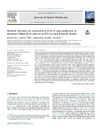Please use this identifier to cite or link to this item:
https://accedacris.ulpgc.es/jspui/handle/10553/73571
| Title: | Nutrient footprint and ecosystem services of carp production in European fishponds in contrast to EU crop and livestock sectors: European carp production and environment | Authors: | Roy, Koushik Vrba, Jaroslav Kaushik, Sadasivam J. Mraz, Jan |
UNESCO Clasification: | 310502 Piscicultura | Keywords: | Cleaner Production Environmental Burden And Ecosystem Services Eu Agriculture And Livestock Sectors Eutrophication Nitrogen And Phosphorus, et al |
Issue Date: | 2020 | Journal: | Journal of Cleaner Production | Abstract: | There have been some arguments concerning supplementary feed (cereals) based common carp production in fishponds and water pollution, mostly in Central Europe. Using Czech Republic (top producer in EU) as a benchmark and combining data on nutrient digestibility of feedstuffs used combined with analyses of literature data, we have assessed – nutrient footprint (∼9.4–10.8 kg N ha−1, ∼2.7–3.2 kg P ha−1; 1.5–4 × < EU crop-livestock sectors); nutrient utilization efficiencies (NUEN ∼36%, NUEP ∼50%; 1.5–1.7 × > EU livestock average); autochthonous nutrient removal (∼8–9.2 kg N ha−1, 1.4–1.6 kg P ha−1); eco-cost burden (13–29 × ≪ positive services); eco-services (∼74.5–100.6 million € country−1; ∼2375 € ha−1) of carp production in Central Eastern European Region (CEER). Digestible nutrients offered by natural prey (7.9% N, 1% P on dry matter basis) to carp are ∼5–8 times higher than those provided by cereals and remains the key determinant for production. Despite this, 70–90% of nutrient footprint from feeding is contributed by cereals. Neutral footprint (∼374 kg ha−1) and exclusively natural (up to 300 kg ha−1) carp production intensities were identified, following which, commercial interest of carp farming may falter (costing intangible losses >56.5 million € in CEER), despite achieving ‘greener-goals’. Per production cycle, carp aquaculture in CEER fishponds offer at least 579 million € worth of services. Our results show that carp production in ponds have lesser nutrient burden than crop and livestock productions in EU. Existing management of fishponds ‘barely meet’ optimum P requirements of common carp and present production intensity should not be vilified as a pollution causing activity. Risks and solutions for achieving both environmental (minimized footprint) and aquaculture goals (uncompromised production) are discussed. | URI: | https://accedacris.ulpgc.es/handle/10553/73571 | ISSN: | 0959-6526 | DOI: | 10.1016/j.jclepro.2020.122268 | Source: | Journal of Cleaner Production [ISSN 0959-6526], v. 270, 122268, (Octubre 2020). |
| Appears in Collections: | Artículos |
SCOPUSTM
Citations
41
checked on Jun 8, 2025
WEB OF SCIENCETM
Citations
42
checked on Jan 18, 2026
Page view(s)
463
checked on Jan 15, 2026
Download(s)
424
checked on Jan 15, 2026
Google ScholarTM
Check
Altmetric
Share
Export metadata
Items in accedaCRIS are protected by copyright, with all rights reserved, unless otherwise indicated.
